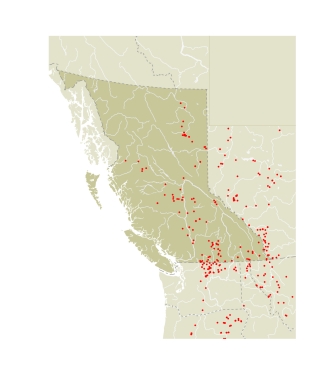Colias is the name of a promontory on the coast of Attica where there was a tem pie of Aphrodite. There is no obvious relationship to the butterfly, but the name may be a pun (Emmet 1991). An alternative explanation is suggested under Pontia. The common name "sulphurs" is derived from the yellow "sulphur" colour of most species.
Sulphurs in BC are generally medium-sized butterflies that are yellow, orange, white, or (one species) yellow green with black markings. The wings of males always have a solid black border, with the exception of the Arctic Sulphur. The black borders of females contain extensive pale areas, or may be greatly reduced or absent. There are several multivoltine species that show considerable seasonal variation in wing colour.
There are about 70 species of Colias in the world. The centre of distribution in North America is BC, with more species (13) than any other province or state. Colias species may all be inter-fertile, with natural hybrids known for most species combinations where they occur together in the wild. The species have behavioural, ecological, and physiological differences that maintain separation of the species in the wild (Hovanitz 1963).
Eggs are laid singly on the leaves of the foodplants, and are pale yellow green to cream, later turning orange. Young larvae are slender, yellowish or green, and smooth-skinned with a thin coat of fine hairs. Mature larvae are yellow green or green with fine black dots all over, and stripes of various colours running along the back and sides. Sulphurs hibernate as second to fourth instar larvae (except Canadian Sulphurs, which hibernate as fifth instar larvae), and then complete development in the spring. There are five larval instars in all Colias (Ae 1958a). Pupae are fastened head up with a girdle around the middle.
Members of the genus utilize a wide range of foodplants, although each species specializes to a greater or lesser extent. Larvae of sulphurs feed on plants in three groups: legumes (Fabaceae), Vaccinium (Ericaceae), and Salix (Salicaceae). Sulphurs occur in a wide range of habitats, including arid sagebrush areas, alfalfa fields, meadows, alpine tundra, and forest bogs.
Sulphurs always rest with their wings folded over their backs, and bask in the sun by leaning to the side to allow the sun to warm the underside of their wings. It has been demonstrated for several species (C. meadii, C. nastes, C. philodice, and C. eurytheme) that the darker the pigmentation on the underside of the wings, the more heat can be absorbed from the sun while basking, permitting greater flight activity in cold environments (Kingsolver 1985).
There is relatively little variation in wing pattern between many species, making identification difficult. The key characters mentioned in the species discussions are shown in the figure.
|
